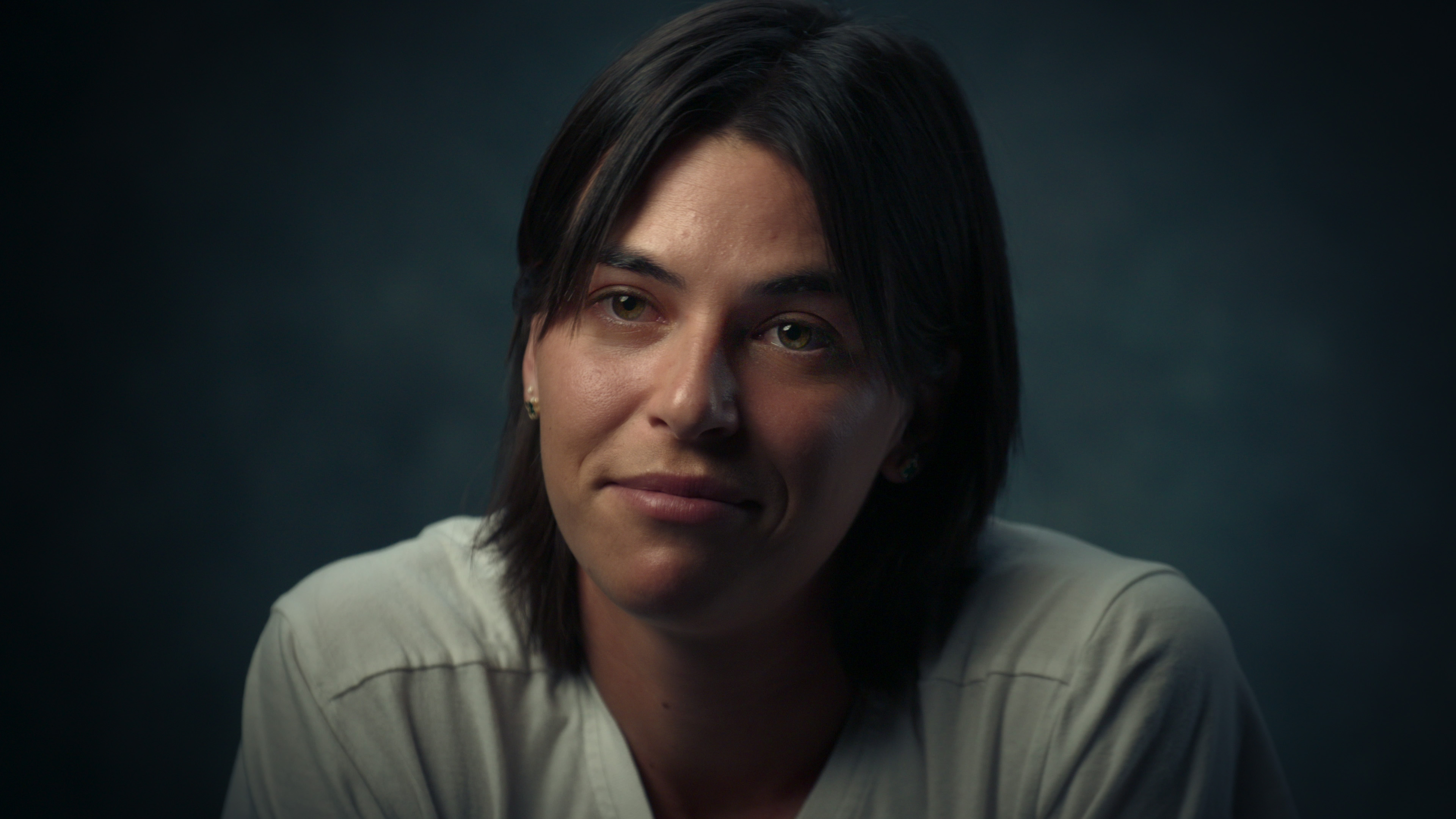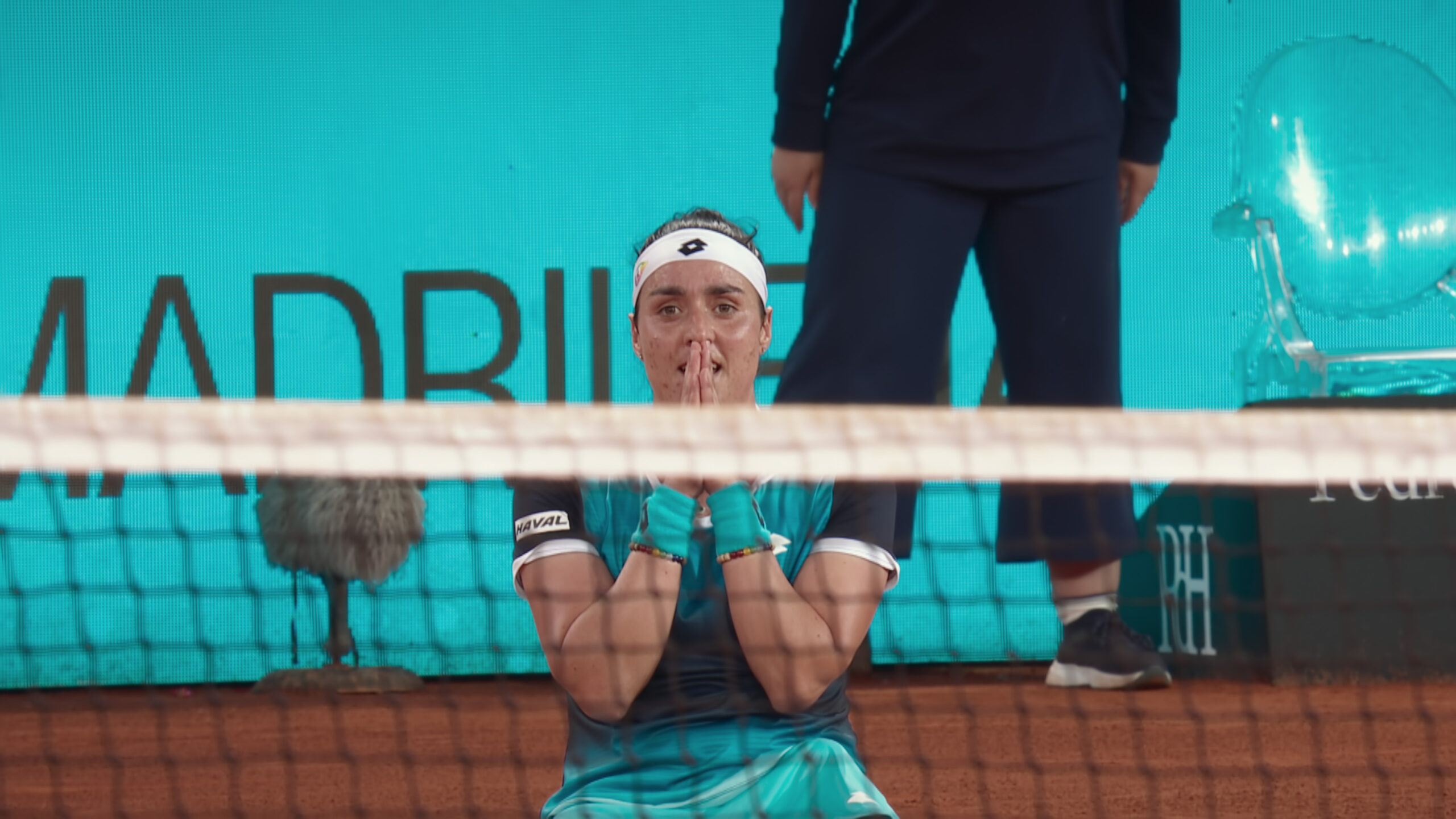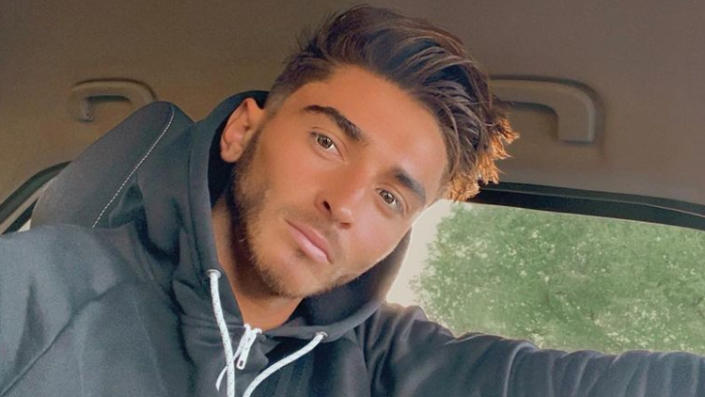Rafael Nadal sprints, slides, and jumps right by his opponents in a hallway at the French Open, occupying a special place inside their heads. In the fifth episode of the new Netflix tennis docuseries Break Point, out on Jan. 13 and produced by the same team behind the popular Formula 1 Netflix series Drive to Survive, the cameras take us behind the scenes right before two different challengers—Félix Auger-Aliassime of Canada, in the fourth round, and Norway’s Casper Ruud in the final—take the court against Nadal at the 2022 French Open. Viewers get a rare, insightful glimpse of Nadal’s warmup routine underneath the stands, before he makes his grand entrance to a worldwide audience. Auger-Aliassime and Ruud can’t help but watch Nadal bounce around. Nadal pays them no mind. Nadal would go on to win the 2022 tournament; he now owns an incredible 14 Roland Garros titles.
This scene neatly encapsulates the tension fueling both Break Point and the tennis world at large: the quest of a new generation of talent to topple generational legends of the game, and pick up the mantle players like Nadal, at some point, will have to leave behind. To date, that quest has proven mostly unsuccessful, as Nadal and Novak Djokovic continue to pile up major tournament trophies, and on the women’s side, Serena Williams continued to cast her strong shadow.
Tennis, however, is entering a period of transition. In a fortuitous bit of timing for Break Point, Williams and Roger Federer decided to stop playing tennis last year. Djokovic and Nadal are entering their late 30s; physics and biology will catch up to them at some point. The documentary chronicles a young, diverse set of would-be champions—like Auger-Aliassame, Ruud, American Taylor Fritz, Ons Jabeur of Tunisia and Ajla Tomljanović of Australia—taking audiences inside messy hotel rooms, to typically unseen practice courts and medical areas, where players grapple with tennis’ excruciating mental, and physical, toll.
Read more: What Serena Williams Gave the World
The Netflix docuseries, which releases five episodes on Friday to be followed by a second installment in June, might let down some casual fans, since it doesn’t go deep with the Big 3 (Djokovic, Nadal, Federer) and Williams. But the Break Point approach works, especially during this key moment of change. Like Nadal in the Roland Garros hallways, the legends are a ubiquitous presence lurking in the shadows. The players’ desire to reach their level—and inability to do so—drive the film’s most searing sequences. “It gives us conflict and stakes,” says Break Point executive producer James Gay-Rees, who serves the same role on Drive to Survive. “It becomes the shark in Jaws.”
Tennis’ power centers—players, Grand Slam organizers, tour administrators—signed on to the Break Point project, hoping that the series will do for tennis what Drive To Survive did for F1: introduce a new generation of fans to the sport. “I think tennis hasn’t helped itself in the past, only really giving three guys attention on tour,” Nick Kyrgios, the controversial Australian who reached the Wimbledon final in 2022, tells TIME. Kyrgios, known equally for his stunning raw talent and cringey on-court outbursts, is the subject of Break Point’s first episode. “Djokovic, Federer, and Nadal, once those guys kind of go, then tennis is going to have a missing identity,” says Kyrgios. “So hopefully this can keep tennis fans engaged.”
Mind Games

Ons Jabeur during a match
Courtesy of Netflix
For viewers, Break Point’s focus on lesser known players comes with advantages. The show chronicles events of the 2022 tennis season. All but hardcore fans, however, may forget the outcomes of key matches involving the likes of Fritz, elevating the drama. Stay away from Google, for example, in the third episode, when Fritz convinces his medical team and coaches, despite their best advice, to play through pain at the Indian Wells tournament to take on Nadal in the final. Fritz grew up in southern California attending the event, dreaming of winning it one day. To beat Nadal there just means too much. He had to give it a shot. (We won’t spoil the result here).
Each episode revolves around one or two players. The first five episodes cover the period from the Australian Open though the French Open. The second batch of five episodes—which covers the rest of the tennis season, including Wimbledon and the US Open—will drop in advance of Wimbledon 2023.
Players featured in the series often open up about difficult subjects. Jabeur, who last year became the first Arab and first African woman to reach a Grand Slam final, grapples with the impracticalities of having children while pursuing a tennis career. “It’s something that touches me personally because I’m someone who wants to have a family,” Jabeur, whose husband Karim Kamoun serves as her fitness coach, tells TIME. “It’s a huge sacrifice, because I’m going to have to wait until I stop. If I was a male, I would have a kid already. I want fans to see that women are making a lot of sacrifices.”
Family psychodrama drives Auger-Aliassime’s arc. The promising Canadian is coached by Nadal’s uncle, Toni Nadal, who mentored his nephew for years. After Auger-Aliassime, 22, won his third round match at Roland Garros, setting up a fourth round duel with Nadal, we see him and Toni chatting while Auger-Aliassime rides an exercise bike. Auger-Aliassime mentions his upcoming match with Nadal. Uncle Toni just runs his hands through his hair, knowing where he stands. For Toni, it’s family first. Going into what could be the defining match of his young career, Auger-Aliassime won’t be receiving any help from his own coach.
Although this arrangement was apparently made clear before Toni and Auger-Aliassime started working together—Toni would recuse himself from matches involving Rafa—Auger-Aliassime pedals in silence, unable to mask disappointment. The moment feels deliciously awkward.
If the episodes share one common thread, it’s the mental toll of tennis. A few players put their struggles in stark terms. “All the negativity coming at me all at once,” says Tomljanović in the film, describing how she feels as an Australian Open match gets away from her. “That little voice in your head doesn’t stop. I blink, and it’s 5-0. Everything stopped being fun.” The cameras watch her confer with her team after the match. They’re all sitting against a wall. “It’s easy, just retire,” says Tomljanović. “It’s screwing up my mind.” A coach asks if she’s all right. She laughs, ruefully, and puts on a mask.
The players’ willingness to address these roadblocks surprised the Break Point producers, given the optics of modern athletics. While athletes in recent years have shown more willingness to discuss psychological strain—Naomi Osaka in tennis, for example, has emerged as a mental health advocate—any sort of perceived weakness is still not typically advertised. “It was very important, for all of us on the team, to explore those ideas of the mind and not shy away from it,” says Break Point showrunner Kari Lia. “It was also really important to the players. They really wanted to talk about it. We didn’t expect that. They wanted us to see how hard it was. To see the moments no one else sees. And be there for that. It was a real privilege to tell those stories.”
Unscripted Drama

Break Point. Felix Auger-Aliassime in Break Point. Cr. Courtesy of Netflix © 2023
Courtesy of Netflix—© 2023 Netflix, Inc.
Box To Box Films, the company founded by Gay-Rees and Paul Martin that did Drive to Survive, was at one point in discussions about an Andre Agassi documentary. Agassi’s 2009 memoir earned widespread critical acclaim, so a follow-up film seemed appropriate. That project fell through, but the filmmakers caught the tennis bug. “For both of us, it sparked this, ‘no one has really got under the skin of tennis like Andre’s book did,” says Martin. “It opened a lot of people’s eyes about, ‘wow, there was this side of tennis I had no idea about. If anything ever came up in the tennis space, we would love to do it, because I don’t think anyone has captured that on screen.’”
COVID stalled some preliminary rumblings. But in February 2021, Gay-Rees and Martin connected with Nick Bourne, chief strategy officer at ATP Media. “We were like, look, given the success of Drive to Survive, there would be an appetite, probably with Netflix,” says Martin. “But could you even do the whole of tennis?” While Formula 1, for example, is a single organizing entity, tennis is much more fractured. A variety of stakeholders—the ATP (men’s) tour, the WTA (women’s) tour, the four Grand Slam tournaments—would all have to buy in, and offer unusual access to prying cameras.
The sport, however, has incentive to grow its audience, like F1 did with Drive to Survive. Bourne and Ugo Valensi, executive director for the Grand Slam Board, worked on getting all the parties to sign on; cameras were rolling at last year’s Australian Open. In September, during the US Open, the Break Point crew occupied office space just north of Arthur Ashe Stadium in New York City. About 20 people were on site, while 40 more were back in London editing existing footage. During a morning meeting, Lia, the showrunner, ran through the day’s match and practice schedules, assigning teams to follow different players. On the wall were pictures of the show’s main characters, such as Jabeur, Fritz, Italy’s Matteo Berrettini and Kyrgios. Those players already knocked out of the tournament—like Fritz and Auger-Aliassime —had a red X in the lower right corner of their frames. One player with no X was Tomljanović, who unbeknownst to everyone in the room, would for one evening become the biggest story in sports. The very next night, in an epic third round match, she would end the tennis career of the greatest player of all-time, Serena Williams.
Love-Love

Ajla Tomljanovic in ‘Break Point’
Courtesy of Netflix
Tomljanović’s magical evening will no doubt be covered in the second batch of Break Point episodes. For now, we see her at the 2022 Australian Open, with her then-boyfriend, Berrettini. (“Meet Matteo Berrettini, The Model Tennis Player Bringing His Good Looks To New York” read a New York Post headline from last August, before the US Open). In the film, she and Berrettini spend time in their hotel room, which appears ransacked, trying to decide on a movie to watch. She suggests The Holiday, a 2006 romantic comedy starring Cameron Diaz and Kate Winslet. Berrettini seems unmoved.
“That movie gets me in such a good mood,” Tomljanovic says. He shakes his head. “I thought you were into horror or comedy,” Berretini says.
“This is comedy,” replies Tomljanović. “Romantic comedy.”
“It’s more romantic than comedy,” says Berrettini.
On another night, Berrettini is peeved that Tomljanović has to wake up early to do a 10-minute interview in their hotel room. Tomljanović has been eliminated from the tournament, while Berrettini is still playing and does not want to hear any morning chatter—a potential disruption to his sleep and routine. “I’m still in the Australian Open!” he says. “Who cares about 10 minutes?” Tomljanović agrees, with some reluctance, to conduct her interview in the hotel business center. Berrettini reached the Australian Open semis, before losing to Nadal.
Professional athletes, especially those toiling in an individual sport like tennis, must remain self-centered. But this approach can strain long-term relationships between players. Tomljanović and Berrettini split sometime last year, after Australia. “Not to put any shade, but my room’s much cleaner now,” says Tomljanović.
Tomljanović believes a key to her growth last season was prioritizing herself. She made the quarterfinals of both Wimbledon and the US Open, following her third round victory over Serena in front of a staunchly partisan pro-Serena crowd. “I’m not going to sit here and be like, ‘Oh, we broke up, I was a new person.’ It wasn’t like that,” she tells TIME. “And when I say prioritizing myself, there’s no shade going to him. But at the same time, you know, that was like a trigger where I was like ‘OK, things have not been good for a while and what do I do moving forward to just be my best self?’ So that was more just like a moment, ‘OK, this needs to stop. I just need things to be better.’”
Before watching her episode of Break Point, Tomljanović was concerned that her mini-spat with Berrettini, over her morning interview, was captured on camera. “I was afraid that I’d come off more pissed off than I was,” she tells TIME. “And looking at it I was like, ‘Oh my gosh, I was so nice about this.’ I was like, ‘Oh, good for me.’ But not really, because I should be like, ‘What the hell?’ But at the same time, I like how the show also showed that, ‘Yeah, to be at the top, to be really great, you have to be selfish.’ You just can’t be in a relationship.”
Not that Tomljanović is ready to completely write off tennis love. “It’s not impossible,” she says. “Because you don’t have to be selfish to that point. Maybe this is the hopeless romantic in me, but I think two tennis players at a good level can make it work. It just has to be two people who fit together well. I still truly believe that.”
Tomljanović has no regrets about inviting cameras into her life. “I hope more people get interested in the sport,” she says. “And maybe have more of an idea of what we go through and maybe be a little easier on us on social media.” As she prepares to chase her first Australian Open title as the highest-ranked Australian woman in the tournament, Tomljanović feels more optimism than ever, given her growth—captured on film—last year.
Legends like Nadal can keep dancing in the shadows. On Netflix at least, a new tennis wave has arrived.
More Must-Reads From TIME







